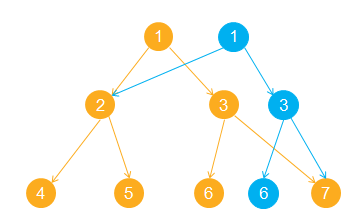以前我们学习了线段树可以知道,线段树的每一个节点都储存的是一段区间,所以线段树可以做简单的区间查询,更改等简单的操作。
而后面再做有些题目,就可能会碰到一种回退的操作。这里的回退是指回到未做各种操作之前的状态。
回退的时候,如果暴力点,就直接将每步所操作的线段树都存下来,然后直接翻阅回去,这种方法虽然简单,但是对空间和时间的需求太大了,肯定不能过。
所以这时候我们就可以选择可持久化操作。
可持久化是数据结构里面的一种方法,其总体就是把一个数据结构的历史状态全部都保存下来,从而能够快速的查找之前出现过的某个操作的结果,并且还可以对其继续操作。但是与直接暴力不一样,做修改的时候,每一次修改,只有一条链上的节点被修改,而其他的节点信息都没有变。因此,我们就可以只对这一次的修改操作新建包括一个新根在内的logn个节点,其他的节点我们与上一课树共用。这样一来,我们既能保存之前的信息,又能进行修改操作。
而一般常用的数据结构里面用到的可持久化的线段树。
可持久化的线段树,又叫主席树。其思想大概就如图。在每一步的线段树操作后将改变的那一条链给单独拎出来,然后新建一次链,而没有改变的链就不动,再将新链与不动的那部分重新组合一下,就成了。

直接看模板裸题吧 https://www.luogu.org/problemnew/show/P3919
#include <bits/stdc++.h> using namespace std; const int maxn = 1e5 + 10; struct node{ int lc,rc; long long int v; }t[maxn << 8];//可持久化线段树 int root[maxn << 5];//root[i]表示版本号为i的线段树的根节点编号 long long int a[maxn];//长度为 N 的数组 int n,m;//n个点,m种操作 int tot; int build(int l, int r) { int pos = ++tot; //版本++ if (l == r) { t[pos].v = a[l]; //记录这个点的值 } else{ int mid=(l+r)>>1; t[pos].lc=build(l,mid); //左子树 t[pos].rc=build(mid+1,r); //右子树 } return pos; } int query(int pos, int p, int l, int r) { //查询版本pos中 a[p]的值 if (l == r) { return t[pos].v; } int mid = (l+r)>>1; if(p <= mid) return query(t[pos].lc, p, l, mid); else return query(t[pos].rc, p, mid + 1, r); } int update(int old, int tar, int c, int l, int r) { //修改 a[tar] 为 c int pos = ++tot; //新开节点时,需要依靠前面构建的节点编号+1 if (l == r) { t[pos].v = c; return pos; } t[pos].lc = t[old].lc; t[pos].rc = t[old].rc; // 将老树复制一份过来 //这里也可以直接写 t[pos] = t[old] ; int mid = l + (r - l)/2; if(tar <= mid) t[pos].lc = update(t[old].lc, tar, c, l, mid); else t[pos].rc = update(t[old].rc, tar, c, mid + 1, r); return pos; } int main(){ while (scanf("%d %d", &n, &m) != EOF) { tot = 0; //代表初始版本 for (int i = 1;i <= n; i++){ scanf("%lld", &a[i]); } root[0] = build(1,n); int v,x,l,w; for (int i = 1;i <= m; i++){ scanf("%d %d %d", &v, &x, &l); if (x == 1) { scanf("%d", &w); root[i] = update(root[v], l, w, 1, n); } else { root[i] = root[v]; printf("%lld\n",query(root[v], l, 1, n)); } } } return 0; }







 博客介绍了线段树可做简单区间查询、更改操作,当遇到回退操作时,暴力存储线段树状态对时空需求大。此时可采用可持久化操作,它能保存数据结构历史状态,修改时仅修改一条链上的节点。常用的可持久化数据结构是可持久化线段树,即主席树,还给出模板题链接。
博客介绍了线段树可做简单区间查询、更改操作,当遇到回退操作时,暴力存储线段树状态对时空需求大。此时可采用可持久化操作,它能保存数据结构历史状态,修改时仅修改一条链上的节点。常用的可持久化数据结构是可持久化线段树,即主席树,还给出模板题链接。
















 1206
1206

 被折叠的 条评论
为什么被折叠?
被折叠的 条评论
为什么被折叠?








